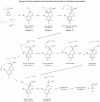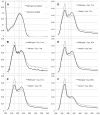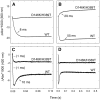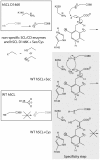Biochemical discrimination between selenium and sulfur 2: mechanistic investigation of the selenium specificity of human selenocysteine lyase
- PMID: 22291978
- PMCID: PMC3266904
- DOI: 10.1371/journal.pone.0030528
Biochemical discrimination between selenium and sulfur 2: mechanistic investigation of the selenium specificity of human selenocysteine lyase
Abstract
Selenium is an essential trace element incorporated into selenoproteins as selenocysteine. Selenocysteine (Sec) lyases (SCLs) and cysteine (Cys) desulfurases (CDs) catalyze the removal of selenium or sulfur from Sec or Cys, respectively, and generally accept both substrates. Intriguingly, human SCL (hSCL) is specific for Sec even though the only difference between Sec and Cys is a single chalcogen atom.The crystal structure of hSCL was recently determined and gain-of-function protein variants that also could accept Cys as substrate were identified. To obtain mechanistic insight into the chemical basis for its substrate discrimination, we here report time-resolved spectroscopic studies comparing the reactions of the Sec-specific wild-type hSCL and the gain-of-function D146K/H389T variant, when given Cys as a substrate. The data are interpreted in light of other studies of SCL/CD enzymes and offer mechanistic insight into the function of the wild-type enzyme. Based on these results and previously available data we propose a reaction mechanism whereby the Sec over Cys specificity is achieved using a combination of chemical and physico-mechanical control mechanisms.
Conflict of interest statement
Figures






Similar articles
-
Exploring the selenium-over-sulfur substrate specificity and kinetics of a bacterial selenocysteine lyase.Biochimie. 2021 Mar;182:166-176. doi: 10.1016/j.biochi.2021.01.002. Epub 2021 Jan 11. Biochimie. 2021. PMID: 33444662 Free PMC article.
-
Biochemical discrimination between selenium and sulfur 1: a single residue provides selenium specificity to human selenocysteine lyase.PLoS One. 2012;7(1):e30581. doi: 10.1371/journal.pone.0030581. Epub 2012 Jan 25. PLoS One. 2012. PMID: 22295093 Free PMC article.
-
Reaction mechanism and molecular basis for selenium/sulfur discrimination of selenocysteine lyase.J Biol Chem. 2010 Apr 16;285(16):12133-9. doi: 10.1074/jbc.M109.084475. Epub 2010 Feb 17. J Biol Chem. 2010. PMID: 20164179 Free PMC article.
-
Selenocysteine in thiol/disulfide-like exchange reactions.Antioxid Redox Signal. 2013 May 1;18(13):1675-89. doi: 10.1089/ars.2012.5013. Epub 2012 Dec 16. Antioxid Redox Signal. 2013. PMID: 23121622 Free PMC article. Review.
-
Selenoproteins-What unique properties can arise with selenocysteine in place of cysteine?Exp Cell Res. 2010 May 1;316(8):1296-303. doi: 10.1016/j.yexcr.2010.02.032. Epub 2010 Mar 3. Exp Cell Res. 2010. PMID: 20206159 Review.
Cited by
-
Exploring the selenium-over-sulfur substrate specificity and kinetics of a bacterial selenocysteine lyase.Biochimie. 2021 Mar;182:166-176. doi: 10.1016/j.biochi.2021.01.002. Epub 2021 Jan 11. Biochimie. 2021. PMID: 33444662 Free PMC article.
-
Effect of Whole Blood Dietary Mineral Concentrations on Erythrocytes: Selenium, Manganese, and Chromium: NHANES Data.Nutrients. 2024 Oct 27;16(21):3653. doi: 10.3390/nu16213653. Nutrients. 2024. PMID: 39519486 Free PMC article.
-
Chalcogen Bonds Involving Selenium in Protein Structures.ACS Chem Biol. 2021 Sep 17;16(9):1622-1627. doi: 10.1021/acschembio.1c00441. Epub 2021 Sep 3. ACS Chem Biol. 2021. PMID: 34477364 Free PMC article.
-
Phenacylselenoesters allow facile selenium transfer and hydrogen selenide generation.Chem Sci. 2024 Oct 29;15(46):19315-19321. doi: 10.1039/d4sc05788k. eCollection 2024 Nov 27. Chem Sci. 2024. PMID: 39568918 Free PMC article.
-
Biological Chemistry of Hydrogen Selenide.Antioxidants (Basel). 2016 Nov 22;5(4):42. doi: 10.3390/antiox5040042. Antioxidants (Basel). 2016. PMID: 27879667 Free PMC article. Review.
References
-
- Allmang C, Wurth L, Krol A. The selenium to selenoprotein pathway in eukaryotes: more molecular partners than anticipated. Biochim Biophys Acta. 2009;1790:1415–1423. - PubMed
-
- Yoshizawa S, Bock A. The many levels of control on bacterial selenoprotein synthesis. Biochim Biophys Acta. 2009;1790:1404–1414. - PubMed
-
- Letavayova L, Vlckova V, Brozmanova J. Selenium: from cancer prevention to DNA damage. Toxicology. 2006;227:1–14. - PubMed
-
- Angstwurm MW, Gaertner R. Practicalities of selenium supplementation in critically ill patients. Curr Opin Clin Nutr Metab Care. 2006;9:233–238. - PubMed
Publication types
MeSH terms
Substances
Grants and funding
LinkOut - more resources
Full Text Sources
Molecular Biology Databases
Research Materials
Miscellaneous

